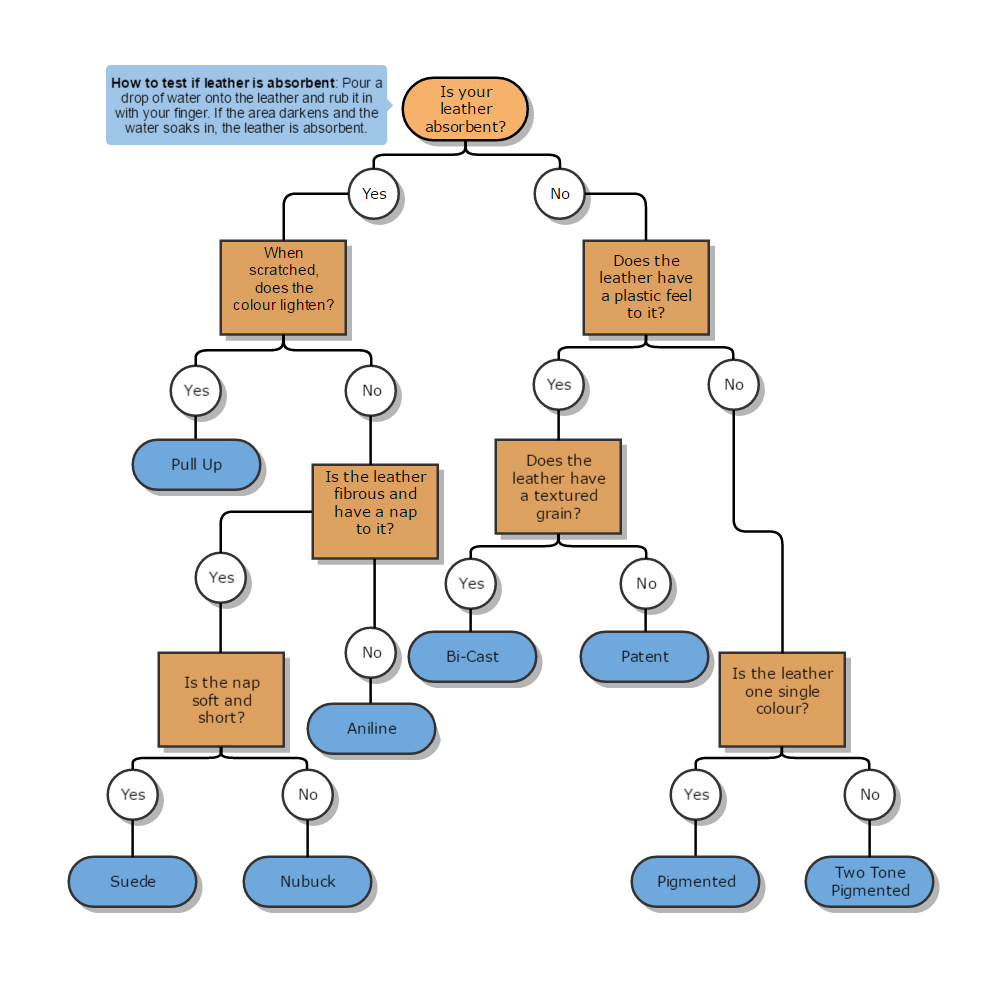Identifying Leather
Whether you're selling leather in a shop or repairing leather professionally, it's important to know the specifics about the material you're working with. Not only to provide a higher level of service to your customer, but knowing the leather type allows you to offer better advice on how best to clean, repair and maintain the leather. There are many different types of leather available, each with its own unique look and feel, but using this simple chart you can easily differentiate between various types.
FURTHER TESTING
In order to properly determine a type of leather, there are a few tests that we can do.
-
Magnifying Glass Test: Looking at leather under a magnifying glass will show us in detail the finish applied to the leather, or if there is a finish on the leather.
-
Water Absorption Test: This test helps us identify how easy your leather will be to clean, and how effective the finish on it is.
-
Visual Test: Looking at leather tells a lot, are there any natural markings visible? What colour is it? etc..
-
Touch Test: Feeling the leather for softness, smoothness, grain pattern also helps identify the leather type.
To make things a little easier for you, we can break down the different types of leather into categories, each containing a group of leathers with similar characteristics and so similar care procedures.
UNFINISHED LEATHER (FULL GRAIN LEATHER)
In this group are all leathers without a lacquered finish applied, maybe with a few exceptions but the finish on these is so light the same identification procedures apply. Also not included in this group are suede and nubuck, this is because their surfaces have been buffed to create a nap and so make them unsuitable for cleaning.
What’s different about these leathers? Because they have either a very thin or no applied finish it makes them very absorbent. Being absorbent means they stain and mark easily. Having no finish also means they can fade very easily, the majority of aniline is just dyed with no lacquered finish and so the leather doesn’t have the greatest colour fastness. Pull up leathers are a bit better than aniline but still need careful maintenance.
FINISHED LEATHER (CORRECTED GRAIN LEATHER)
In this group, we will include all leathers with a lacquered finish.
- Semi-Aniline (this is an exception as it is a full grain leather)
- Pigmented (also known as top coated or corrected grain)
- Bi-cast
- Rub Off (also known as Antique Finish)
All the above have a lacquered finish and so are very easy to clean and maintain, bi-cast has a plastic coating bonded to the finish and so falls in this category. Rub off leather has been starred, WHY? Because the top coat lacquer is very weak, this means when you clean it the black top coat may easily wear away exposing the brighter colour beneath. Be careful when dealing with this leather type.
NUBUCK & SUEDE
These leathers have a nap texture and no top coat finish applied. This makes them stain very easily and because these stains are absorbed, very difficult to clean.
We have developed highly effective products for both cleaning and protecting items made from suede and nubuck leathers. Our Suede & Nubuck Cleaner offers powerful cleaning with an innovative foaming action, that ensures amazing results and uses less product when cleaning, saving you money.
To protect your items; our Suede & Nubuck Protector is specifically formulated to repel dirt and all water and oil based staining from the surface of any suede or Nubuck item. This incredibly durable barrier gives you complete piece of mind and significantly extends the life of your items.




